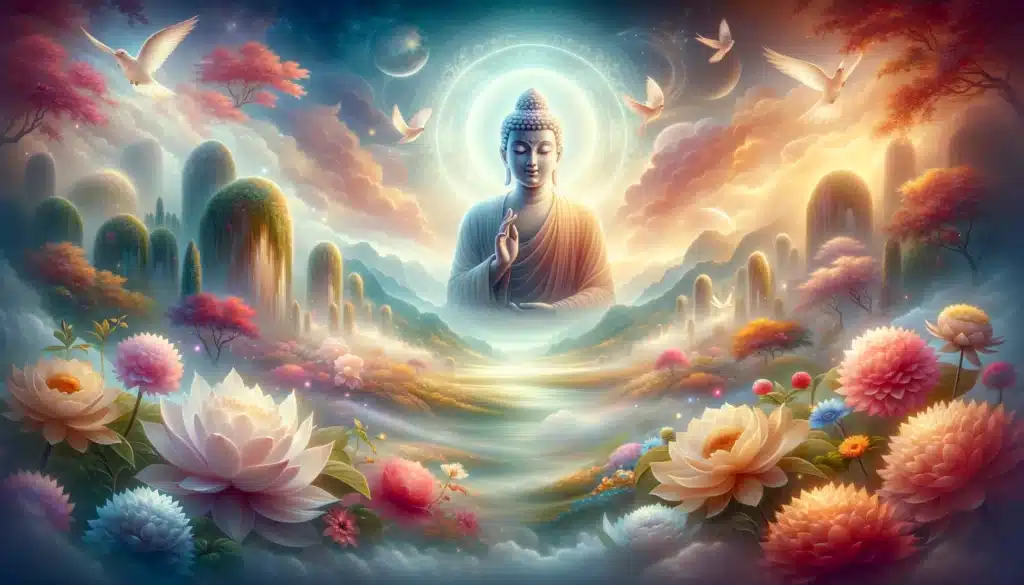Have you ever come across the fascinating statement “All things are created by the mind” in the Avatamsaka Sutra and wondered what it really means? This is said to be one of the profound teachings of Buddha to his disciples.
When you hear this statement, you will certainly be surprised and deny it. Why is the world around us, specifically physical things like plants, houses, and things, created by the mind? Matter comes first and we are just observers, right!
To gain a deeper understanding of this wonderful teaching, LotusBuddhas invites you to join us in peeling off each layer of meaning, analyzing them from which you will know how to draw a realistic image of reality with the strokes of your mind.
What is ‘All Things are Created by The Mind’?
You may have encountered the idea that “everything is created by the mind” in Buddhist works, specifically in the Avatamsaka Sutra. This saying seems confusing but has a deep meaning. It means objects, events, everything – originates from our mind. This phrase is not only about thoughts but also about how we perceive reality.
For example: When you observe a tree, you think that it has appeared before, it is still standing there, right! This is the view of ordinary people, not Buddhist wisdom. Buddhism says that if there was no one standing there observing the tree, would the tree even exist? When you stand there and see it, it exists – your mind confirms that it exists. Let’s talk a little about the color of the tree. Humans see a tree with green leaves and red flowers… but from the dog’s perspective it’s different, the dog sees gray, from the fly’s perspective the tree’s leaves are light purple. So what is the true color of that tree? Next we talk about perspective. That tree is short and its trunk is rough, so you think it is an ugly tree, but other people like it that way and think this tree is very beautiful. So in the end, is that tree beautiful or ugly?
You understand the problem now! The existence of a tree, its color, or its appearance is governed by the reference filter of your mind. This is the reason why Buddhism teaches: “All Things are Created by The Mind.”
Therefore, this profound teaching does not simply state the nature of reality but also serves as a guide for practitioners on the path of spiritual development. It reminds us that how we experience life depends greatly on our state of mind and perception. Cultivating a positive, compassionate, mindful mindset allows influencing our experience of the world to achieve peace and wholeness.
Is This Statement Materialistic or Idealistic?
“All things are created by the mind” is idealistic in the understanding of Marxism-Leninism.
The idea “Everything is created by the mind” seems more idealistic than materialistic. Because materialist perspectives such as Marxism-Leninism believe that our surroundings and physical conditions shape our consciousness and perception. This view holds that physical reality determines our thoughts, emotions, and perceptions. The physical world determines our consciousness.
Mary Ann Bevan was a bad woman and everyone recognized it. So why do we say everything is created by the mind, ugliness or beauty, happiness or suffering are all created by the mind?
The nature of fire is hot and ice is cold. If anyone comes into contact with fire, they will experience pain and discomfort. So why do we say that the heat of fire and the pain when exposed to fire are only created by the mind?
“Material determines consciousness” and “All things are created by the mind” have a huge contradiction!
However, the statement “All things are created by the mind” implies that our perception, our consciousness, creates our reality. This idea aligns more closely with idealism, especially in the context of Eastern philosophy and some interpretations of Buddhist thought. It proposes that the mind is not just a passive recipient of external stimuli but also actively constructs or influences our experience of the world.
Every day when you come home from work, your beloved dog curls up at your feet and you’re very happy about that. One afternoon, you come home and your beloved dog curls up at your feet. But in a tired mood from work pressure, because you just had an argument with your lover, you angrily kicked the dog aside because it was bothering you. Why do we feel differently about the same action?
Some stories from Eastern lands tell us minds can make the world look different. When sad, things may seem harsh. When happy, skies brighten. Our emotions impact our life views. This isn’t so odd: our minds shape how we experience reality. It fits science’s ideas that our brains mostly decide what’s “real.”
Science supports that our minds and brains shape our reality view. So, “All things are created by the mind” highlights how our inner state colors our outer reality perception, not that the physical world solely decides our consciousness.
The saying points to the mind’s role in shaping experience and interpreting reality, rather than claiming external material conditions alone determine awareness. It emphasizes the mind’s part in constructing our reality sense over purely physical factors.
Is The Saying “All things are created by the mind” from Buddhism?
The saying “All things are created by the mind” indeed originates from Buddhism but is often misunderstood. This phrase does not literally mean that everything is created by the mind. Instead, it suggests that everything we perceive through our senses – what we see, hear, smell, taste, and touch – is conceptualized in our consciousness.
Here’s an easier-to-understand example: Consider how different people react to the spiciness of chili peppers. One person may find it unbearably hot, while another may find it only moderately spicy. Or take a piece of music – one person may find it absolutely wonderful, while another may find it dull. Same chili or same music, but our personal experiences and perceptions shape how we interpret these things. This concept illustrates how our individual mental states and perceptions can dramatically alter our experience of the same reality.
In Buddhism, this concept is about understanding that our perception of reality is shaped by our mind. For example, object A remains object A in reality, but it is perceived differently by each individual based on their unique mental conditioning and understanding. This is why it’s said that things are ‘created’ by the mind.
It’s crucial to note that natural elements like earth, water, fire, and air are not created by the mind. Rather, our understanding and subjective thoughts about these elements are shaped by our individual perceptions and mental constructs. Therefore, the same object or phenomenon can evoke different ideas and impressions in different people.
The real meaning behind “All things are created by the mind” is not to be interpreted as an endorsement of idealism, where everything is believed to be a creation of the mind. It’s more about recognizing how our perceptions and conceptions shape our understanding of the world.
In Buddhism, when the mind reaches a state of complete stillness and purity, free from all conceptualization and fabrication, it is said to be in a state of Nirvana. Nirvana is the cessation of all mental fabrications that create the Three Worlds (Desire Realm, Form Realm, and Formless Realm). These worlds are formed through consciousness, leading to the saying “Three Worlds are only mind; all phenomena are only consciousness.” This phrase is perhaps a clearer expression than “All things are created by the mind”, which can be mistakenly interpreted as a purely idealistic view.
Buddhism is Not an Idealistic Religion, But Why is Zen Buddhism Called Idealistic Buddhism?
Buddhism isn’t tied to idealism or materialism in philosophy. It focuses on understanding how phenomena exist due to conditions, not being inherently born from anything.
In Buddhism, mind and matter interplay, known as dependent origination. This involves psychological, physiological, and physical aspects interacting. No single element creates the others supremely. Talking about ‘creation’ here already introduces a duality Buddhism transcends.
Zen Buddhism gets labeled ‘Idealistic Buddhism’ sometimes. However, this doesn’t mean it advocates the philosophical concept idealism that everything is mind-constructed. In Zen, the focus lies on the mind’s role for enlightenment. But it doesn’t propose all forms are mental constructs in the idealistic sense.
Zen practice emphasizes transcending usual sensory perceptions. It aims to experience reality as the Pabhassara Citta – the luminous, clear, pure mind perceives it. This approach sees things’ true nature, unclouded by conceptualizations or preconceptions about what they should be. Zen isn’t about the mind creating forms. Rather, it perceives forms’ true essence without thought and conceptualization distortions.
Zen Buddhism is different from Western idealism. It pays great attention to the mind’s role. But it does not believe everything is mental. Zen is about really seeing things. Not how the mind usually makes them up. It’s about experiencing things’ true nature. Beyond the usual mental fabrications.
If When We Die Our Mind is Clear and Pure, We Will See Nirvana?
In Buddhist thought, reaching Nirvana isn’t necessarily about waiting until death with a clear and pure mind. Rather, Nirvana, just like hell or any other realm, is more about our current mental state and how we perceive and interact with life. It’s not about doing something specific to get to a physical place called Nirvana that exists somewhere else. Nirvana, or hell, or any other state of existence, can be right here and now, depending on our mindset.
- Right here, right now, if we have a completely selfless, altruistic mind, that is the mind of a Buddha or a Bodhisattva.
- If we are entirely pure and liberated, that is the mind of an Arahant.
- If we are fully in harmony with the Dharma, that’s the mind of one on the path of Stream-Entry (Sotāpatti Magga).
- If we are kind, joyous, and liberated, that is the mind of the heavenly realms.
- If we live a decent, reasonable life, that is the human realm.
- If we live only for basic pleasures like eating and sleeping, that’s akin to the animal realm.
- If we are constantly craving and desiring things, that is the mind of a hungry ghost.
- If we crave power, wanting to control others at home or outside, that is the mind of an Asura, quick to anger when not obeyed.
- If we live in hatred, deceit, and cruelty, that’s like being in hell.
Thus, our attitude towards reality shapes our experience of happiness or suffering. We have many choices, and it’s up to us to decide how we want to live and perceive our world. It’s about realizing that these states are not physical places we go to, but rather ways of being and perceiving that we can experience right here in the present, based on our mental and emotional states.
Conclusion
The saying “All things are created by the mind” encapsulates a powerful insight into the nature of our perception and experience. As Zen Master Thich Minh Niem points out, our reality is significantly shaped by our state of mind. When our mind is peaceful, we feel the world around us is harmonious and stable. On the contrary, when our minds are in trouble, chaos, stress, anger, doubt or fear, we tend to see everything around us as problematic and unstable.
Now, consider a tiger, a creature known for its danger. If we enter a tiger’s enclosure with a peaceful mind, will we remain undisturbed, or will fear inevitably arise? The concept of “All things are created by the mind” raises a question: if we believe the tiger poses no danger, does that change its inherent nature? Similarly, if we think of fire as something comforting, how does that affect our actual physical interaction with it?
You must know this is not the mind constructing physical reality. Instead, it is the way our minds color our experiences. Our minds are constantly working to help us adapt and survive in this world. If they are unaware or ignorant, we risk losing our conscious engagement with life. In Zen practice, becoming completely disengaged or lethargic (described as “cold ash” or “rotten wood”) is ineffective.
When navigating life’s path, no extreme – overcommitting yourself to suffering or total indulgence – is ideal. The life and teachings of Buddha represent balance. He did not sit under the Bodhi tree to become ignorant or stupid. He also did not immerse himself in earthly life to the point of suffering.
Buddha taught that things in themselves are not inherently scary or hateful. Hide from the world or seek isolation to avoid the misunderstandings and challenges of life. “All things are created by the mind” is a method of training the mind. It helps us avoid negative states that cause suffering to ourselves and others.
The enlightened person sees the true nature of things as they are. They act in the best interest of themselves and others. This understanding can change the way we interact with the world. It leads us to a more positive, beneficial approach to life. It is important to master our mind and perception. Our happiness and peace largely depend on how we choose to perceive and interact with the world around us.










